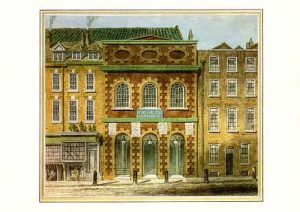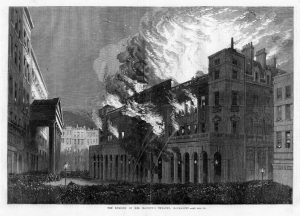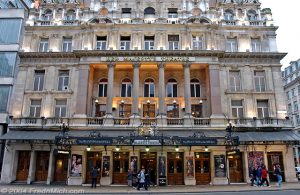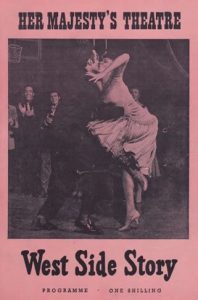Her Majesty’s Theatre
Sul sito sul quale sorge l’attuale Her Majesty’s Theatre vi sono stati in precedenza altri quattro teatri che hanno cambiato svariati nomi nel corso della storia.
 Il primo di questi teatri risale al 1703, ma fu inaugurato nel 1705 con il nome di Queen’s Theatre in onore della Regina Anne, che aveva accordato a John Vanbrugh la licenza reale. La prima produzione ad essere messa in scena nel teatro fu anche, contemporaneamente, la prima opera Italiana ad essere rappresentata in un teatro londinese: The Lovers of Ergasto (Gli Amori di Ergasto). Nel 1707 John Vanbrugh mise in vendita il teatro, che fu preso in affitto da Owen Swiny Owen Swiny.
Il primo di questi teatri risale al 1703, ma fu inaugurato nel 1705 con il nome di Queen’s Theatre in onore della Regina Anne, che aveva accordato a John Vanbrugh la licenza reale. La prima produzione ad essere messa in scena nel teatro fu anche, contemporaneamente, la prima opera Italiana ad essere rappresentata in un teatro londinese: The Lovers of Ergasto (Gli Amori di Ergasto). Nel 1707 John Vanbrugh mise in vendita il teatro, che fu preso in affitto da Owen Swiny Owen Swiny.
Nel 1714, in seguito all’ascesa al trono di Re George I, il teatro venne rinominato The King’s Theatre e mantenne questo nome fino al 1789 quando l’edificio venne distrutto da un incendio durante alcune prove notturne.
 Appena due anni dopo, nel 1791, venne inaugurato un nuovo teatro con il nome di King’s Theatre; le prime opere ad essere messe in scena furono Don Giovanni (1817) e Il Barbiere di Siviglia (1818). In questo periodo, e fino al 1820, il teatro fu celebre come Italian Opera House poiché venivano messe in scena numerose opere di Gioacchino Rossini. Molte furono anche le opere di fama mondiale ad essere rappresentate per la prima volta in questo teatro. Tra le più note ricordiamo La Clemenza di Tito, composta da Mozart nel 1806, e Così Fan Tutte. Tra il 1816 e il 1818 l’esterno del teatro venne ridisegnato da due architetti (J. Nash e G. Repton) e venne aggiunta, sul retro dell’edificio, una galleria di negozi chiamata Royal Opera Arcade. Con l’ascesa al trono della Regina Vittoria, il teatro cambiò nuovamente nome in Her Majesty’s Theatre, Italian Opera House. L’edificio (al tempo sotto la gestione di James H. Mapleson) fu nuovamente distrutto dalle fiamme nel 1867.
Appena due anni dopo, nel 1791, venne inaugurato un nuovo teatro con il nome di King’s Theatre; le prime opere ad essere messe in scena furono Don Giovanni (1817) e Il Barbiere di Siviglia (1818). In questo periodo, e fino al 1820, il teatro fu celebre come Italian Opera House poiché venivano messe in scena numerose opere di Gioacchino Rossini. Molte furono anche le opere di fama mondiale ad essere rappresentate per la prima volta in questo teatro. Tra le più note ricordiamo La Clemenza di Tito, composta da Mozart nel 1806, e Così Fan Tutte. Tra il 1816 e il 1818 l’esterno del teatro venne ridisegnato da due architetti (J. Nash e G. Repton) e venne aggiunta, sul retro dell’edificio, una galleria di negozi chiamata Royal Opera Arcade. Con l’ascesa al trono della Regina Vittoria, il teatro cambiò nuovamente nome in Her Majesty’s Theatre, Italian Opera House. L’edificio (al tempo sotto la gestione di James H. Mapleson) fu nuovamente distrutto dalle fiamme nel 1867.
 Il terzo teatro venne progettato da Charles Lee che prevedeva di utilizzare materiali che potevano resistere al fuoco; purtroppo, a causa di dispute sulla gestione del teatro, l’edificio rimase chiuso fino al 1874.
Il terzo teatro venne progettato da Charles Lee che prevedeva di utilizzare materiali che potevano resistere al fuoco; purtroppo, a causa di dispute sulla gestione del teatro, l’edificio rimase chiuso fino al 1874.
Nel 1892 venne ordinata la demolizione del teatro, la cui ricostruzione fu finanziata quattro anni dopo da Herbert Beerbohm Tree. Il progetto venne affidato a C. J Phipps e il nuovo teatro fu inaugurato cinque anni dopo, nel 1897, con la messa in scena di un’opera di Gilbert Parker: “Seats of the Mighty”.
Nel 1901, a seguito della morte della Regina Vittoria, il teatro cambiò nuovamente nome in His Majesty’s Theatre, in onore del nuovo monarca Re Edoardo VII. L’edificio fu successivamente anche il luogo in cui si tenne l’incoronazione di Giorgio V (1911).
Nel 1904 Herbert Beerbohm Tree fondò la Royal Academy of Dramatic Art (RADA), una tra le più rinomate scuole di teatro del mondo che inizialmente aveva sede nella Dome Room (stanza che Tree aveva fatto adibire ad appartamento personale situato sotto la cupola di bronzo). L’anno successivo la scuola trasferì la propria sede a Bloomsbury, dove si trova ancora oggi.
 Per tutta la durata del ventesimo secolo il teatro mise in scena principalmente musical; tra i musical che ottennero più successo possiamo ricordare, ad esempio West Side Story di Leonard Bernstein (1958), Lock Up Your Daughters di Lionel Bart e Laurie Johnson (1962) e Fiddler on the Roof (1967). Venne inoltre messa in scena una versione musical di The Phantom of the Opera che nel 2011 ha celebrato il venticinquesimo anniversario; l’opera è infatti la rappresentazione più longeva e di maggiore successo che il teatro abbia avuto.
Per tutta la durata del ventesimo secolo il teatro mise in scena principalmente musical; tra i musical che ottennero più successo possiamo ricordare, ad esempio West Side Story di Leonard Bernstein (1958), Lock Up Your Daughters di Lionel Bart e Laurie Johnson (1962) e Fiddler on the Roof (1967). Venne inoltre messa in scena una versione musical di The Phantom of the Opera che nel 2011 ha celebrato il venticinquesimo anniversario; l’opera è infatti la rappresentazione più longeva e di maggiore successo che il teatro abbia avuto.
Sitografia
https://www.londontheatres.co.uk/her-majestys-theatre/history/ “Her Majesty’s Theatre”, LondonTheatres.co.uk. [Ultima consultazione il 1/05/19].
https://lwtheatres.co.uk/theatres/her-majestys/about-her-majestys-theatre/ “About her majesty’s theatre”, LWtheatres. [Ultima consultazione il 1/05/2019].
ENGLISH VERSION.
Her Majesty’s Theatre
The place where the Her Majesty ‘s theatre is located nowadays hosted other four theatres, which changed various names throughout history.
The first one of these theatres dates back to 1703, but it was inaugurated only in 1705 under the name of Queen’s Theatre in honour of Queen Anne, who conceded the royal license to John Vanbrugh. The first production staged in this theatre was also the first Italian production performed in a Londoner theatre: The Lovers of Ergasto (Gli amori di Ergasto). In 1707 John Vanbrugh decided to sell the theatre, which was successively rented by Owen Swiny.
In 1714, after the King George I’s ascended to the throne, the theatre was called The King’s Theatre and kept this name until 1789, when the building was destroyed by flames during some night rehearsals.
In 1791, a new theatre called King’s Theatre was inaugurated and its first plays performed there were Don Giovanni (1817) and Il Barbiere di Siviglia (1818). In that period, and until 1820, the theatre was known as Italian Opera House, because many works by Gioacchino Rossini were staged there. Various world-renowned performances were first staged in this theatre, such as La Clemenza di Tito, composed by Mozart in 1806 and Così Fan Tutte. Between 1816 and 1818 the exterior was redesigned by two architects (J. Nash and G. Repton) and on the building’s back side was added a shops gallery called Royal Opera Arcade. After Queen Victoria was crowned, the theatre changed again its name and became Her Majesty’s Theatre, Italian Opera House. The building (at the time under the management of James H. Mapleson) was destroyed again by flames in 1867.
The third theatre was designed by Charles Lee, who planned to use fire-proof materials; unfortunately, the building remained closed until 1874 because of the debates concerning the theatre’s management.
In 1892, the theatre was demolished and its rebuilding was financed only four years later by Herbert Beerbohm Tree. C. J Phipps was in charge of the new theatre’s project, which was inaugurated in 1897 with the staging of Seats of the Mighty, a play by Gilbert Parker.
In 1901, after the Queen Victoria’s death, the theatre changed again its name in His Majesty’s Theatre, in honour of the new monarch King Edward VII. Subsequently the building was also the place of George V’s coronation (1911).
In 1904 Herbert Beerbohm Tree founded the Royal Academy of Dramatic Art (RADA), one of the most world-renowned theatre school, which initially had its headquarters in the Dome Room (a room right under the bronze dome that Tree had assigned as his personal apartment). One year later the school headquarters was moved to Bloomsbury, where it is still today.
Through the twentieth century the theatre mainly staged musicals; works such as West Side Story by Leonard Bernstein (1958), Lock Up Your Daughters by Lionel Bart and Laurie Johnson (1962) and Fiddler on the Roof (1967) were the most successful. At the RADA was also staged a musical version of the The Phantom of the Opera, that in 2011 has celebrated its twenty-fifth anniversary: this musical is the most long-running and successful performance that the theatre has ever had.
